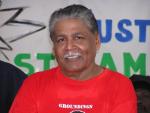By Raffique Shah
June 23, 2020
 Christopher Columbus had his comeuppance coming for a long, long time. Five hundred years, to be more specific. Here was an Italian adventurer, brigand and explorer who persuaded Queen Isabella of Spain to invest in an expedition he had been obsessed with—sailing into the unknown West and finding the mythical city of gold, El Dorado, and claiming it, and other lands, on behalf of the monarch.
Christopher Columbus had his comeuppance coming for a long, long time. Five hundred years, to be more specific. Here was an Italian adventurer, brigand and explorer who persuaded Queen Isabella of Spain to invest in an expedition he had been obsessed with—sailing into the unknown West and finding the mythical city of gold, El Dorado, and claiming it, and other lands, on behalf of the monarch.
Between 1492 and 1498, he would make three such expeditions, “discovering” the Americas and the Caribbean in the process, decimating the friendly native Amerindians as they went along, giving birth to another savage intervention of Europeans in the history of civilisation.
Columbus was by no means unique in his exploits: other seafaring adventurers, mostly from Europe, sailed to hitherto unknown continents and islands across the world and laid claims to them, totally disrespecting the indigenous populations they encountered. They exterminated those who resisted the occupation of their territories, and enslaved huge numbers of those who were prepared to coexist with the interlopers.
When my generation was first tutored in history as a subject at primary school, we were taught about the Caribs and Arawaks, the two main tribes of the indigenous people who inhabited the islands of the Caribbean. One tribe was said to be hostile and warlike, the other peaceful. But they lived here long before our ancestors arrived, or, indeed, Columbus and other explorers before and after him did.
Yet, our teachers insisted that Columbus discovered Trinidad, that he dropped anchor off Moruga and sent some men ashore to seek supplies, and, importantly, directions to the city of El Dorado. When we students would point out to the teachers the inconsistency between Columbus’s “discovery” and the Amerindians’ presence here, they would reply, “Boy, the book says so!” or “I didn’t write the book!”
As I grew older and read and studied European colonisation of the wider world, and the expansion, in particular, of the British empire “on which the sun never set”, I realised we had been made to believe lies, and that men like Columbus, Francis Drake, Walter Raleigh and others of similar ilk, were pirates and bandits who had been glamourised by their monarchs and the societies they came from because their plunders enriched the mother-countries and pauperised the colonies.
Oh, without doubt, they also established education systems that gave the natives opportunities to learn and master their (the colonisers’) histories, established order and laws that appeared to benefit us, so we would believe their motives were altruistic. Indeed, such was the insidious nature of colonialism, its penetration of the psyche of the colonised, many would fight, and if necessary, die to defend the systems.
It was an explosion of this type, of young and restless men and women who challenged the colonial power structure back in the 1960s and 1970s that shook the world, but more fundamentally, the established order. That included Columbus, images of him and other brigands that symbolised the old order, that we, the rebels of that era, fought to destroy. We were condemned by many in the society who were comfortable with the power-structures, and with the Columbuses.
Which is why, when, today, I see another generation take our place, grab the batons-of-change, and run with them, I smile and feel hopeful. In fact, I hope they see the bigger picture, the broader canvas, in a manner of speaking. They do not need to waste time reinventing the wheel. Read Walter Rodney’s How Europe Underdeveloped Africa and Eduardo Galeano’s Open Veins of Latin America.
When you digest the real issues that you should be addressing, you will go after substance, not symbols. Symbols such as statues of Columbus and sundry slavers are offensive, and deserve to be removed from public spaces. But you must take aim at the economic order that men like Columbus built and left behind to perpetuate the old order to continue to exploit the masses.
I shall leave readers with a teaser. Of a world population of approximately 7.8 billion, at least five billion start their day with a cup of coffee. The main ingredient in those mountains of cups is a bean that grows only in tropical countries—Central and South America, parts of Central Africa, India, Vietnam.
Who makes fortunes from coffee? Huge food companies headquartered in North America and Europe. Think of how this rich-poor gap will change if one US cent per cup filters back to the poor of the coffee-producing countries. Similar inequities exist in the producing-consuming worlds of tea and cocoa (beverages), and I have only scratched the surface of one commodity, one equation that is all wrong, that is configured to benefit the few at the expense of the many.
So yes, children, go after and remove symbols of a bitter past. But if you want meaningful change, tackle issues of substance that will impact real lives, billions of lives.
